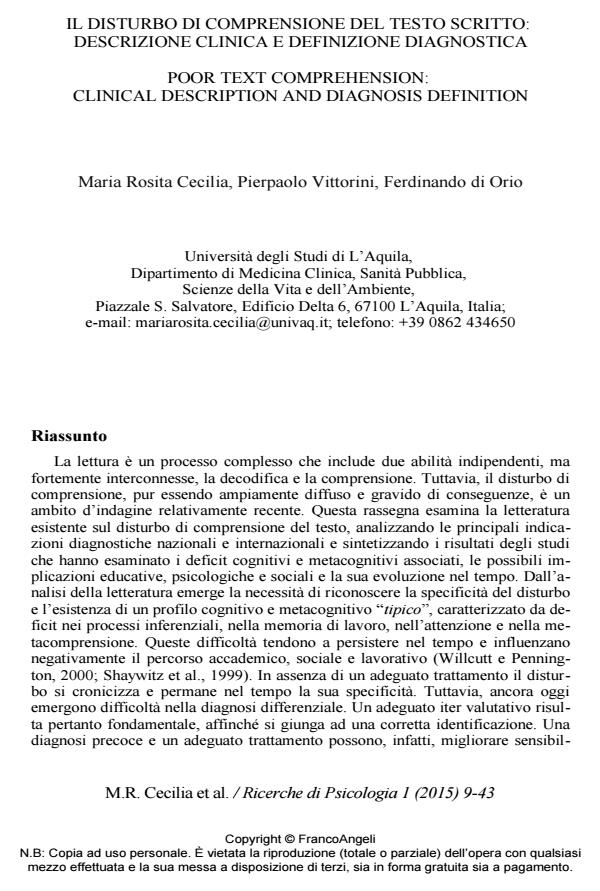Poor text comprehension: clinical description and diagnosis definition
Journal title RICERCHE DI PSICOLOGIA
Author/s Maria Rosita Cecilia, Pierpaolo Vittorini, Ferdinando di Orio
Publishing Year 2015 Issue 2015/1
Language Italian Pages 35 P. 9-43 File size 322 KB
DOI 10.3280/RIP2015-001001
DOI is like a bar code for intellectual property: to have more infomation
click here
Below, you can see the article first page
If you want to buy this article in PDF format, you can do it, following the instructions to buy download credits

FrancoAngeli is member of Publishers International Linking Association, Inc (PILA), a not-for-profit association which run the CrossRef service enabling links to and from online scholarly content.
Reading is a very complex process that includes two independent, but strongly interconnected skills, decoding and comprehension. However, poor text comprehension, although widespread and with critical consequences, is a relatively new area of investigation. This review examines the existing literature on poor text comprehension, analyzing the main national and international diagnostic indications and synthesizing the results from studies that have examined the related cognitive and metacognitive deficits, the potential educational, psychological and social effects and its development. Literature analysis confirms the need of recognizing the specific nature of the disorder and the existence of a "typical" cognitive and metacognitive profile, characterized by specific deficits in inferential processes, working memory, attention and metacomprehension. These difficulties tend to persist over time and negatively affect academic, social and occupational path (Willcutt e Pennington, 2000; Shaywitz et al., 1999). In the absence of proper treatment, the disease becomes chronic and lasts through time in its specificity. However, the differential diagnosis may be still difficult. Therefore, adequate assessment process is essential for proper identification. Indeed, early diagnosis and proper treatment can substantially improve the prognosis (Torgerson e Elbourne, 2002), reducing the risk of chronic disability, with positive effects on the child and his/her family, but also on the community, through a reduction of costs for assistance (Carretti at al., 2002).
Keywords: Poor comprehenders, specific learning disorders, reading comprehension.
- School Refusal in Students with Low Academic Performances and Specific Learning Disorder. The Role of Self-Esteem and Perceived Parental Psychological Control Pina Filippello, Caterina Buzzai, Giovanna Messina, Antonina Viviana Mafodda, Luana Sorrenti, in International Journal of Disability, Development and Education /2020 pp.592
DOI: 10.1080/1034912X.2019.1626006
Maria Rosita Cecilia, Pierpaolo Vittorini, Ferdinando di Orio, Il disturbo di comprensione del testo scritto: descrizione clinica e definizione diagnostica in "RICERCHE DI PSICOLOGIA " 1/2015, pp 9-43, DOI: 10.3280/RIP2015-001001